Read Reviews
The Best Door Mats
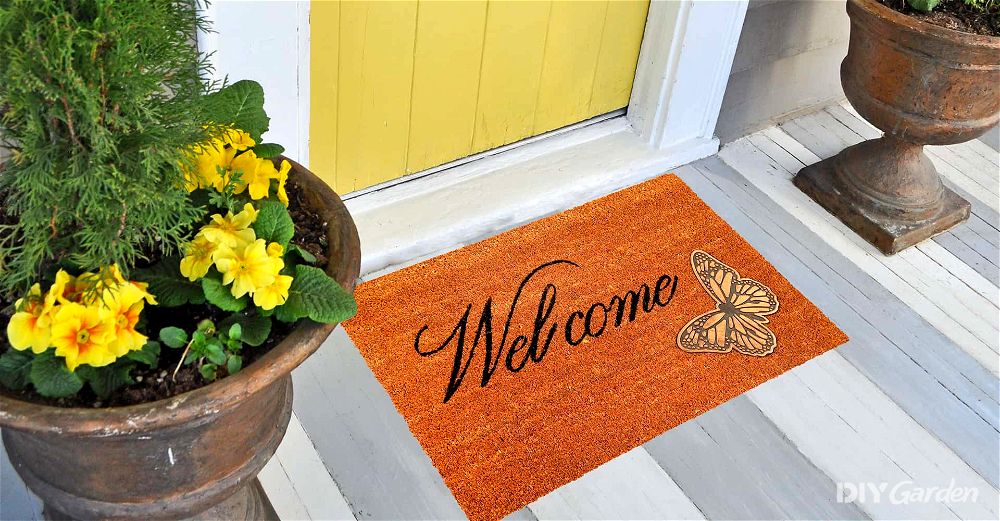
-
Best for indoors & outdoors - Mibao Door Mat Dirt Trapper for Indoor and Outdoor
-
Best coir door mat - Coco & Coir Heavy Duty Outdoor Door Mat
-
Best decorative door mat - Black Ginger Large Thick Decorative Coir Door Mat
-
Best budget door mat - Trendsco Dirt Trapper Door Mat Indoor & Outdoor
-
Best value door mat - GULLAMBO Door Mat for Indoor & Outdoor
-
Best microfibre door mat - Color G Door Mat
-
Best absorbent door mat - Lifewit Indoor Doormat Super Absorbent
-
Best for low-hanging doors - Homaxy Washable Door Mat
-
Best non-slip door mat - Nicoman Non-Slip Barrier Doormat Eco-Friendly
-
Best half moon door mat - Mibao Half Round Door Mat
Door Mat Reviews
1. Mibao Door Mat Dirt Trapper for Indoor and Outdoor[ SAVE 15% ]
Best for indoors & outdoors
- Has good grip on wooden and other smooth floors
- Low profile means it can fit under low-hanging doors that may catch on other mats
- Feels sturdy and strong thanks to the rubber backing
- Easy to clean in the washing machine
- Available in a range of colours
- Arrives folded which makes it hard to get flat when removed from the packaging
- Shape
- Rectangular
- Size
- 40cm x 60cm
- Colour
- Black Grey
- Material
- Polypropylene
- Design
- 4.5
- Durability
- 5
- Value for Money
- 5
The Mibao Door Mat Dirt Trapper for Indoor and Outdoor is a versatile doormat, suitable for use both inside and out.
Designed to catch dirt and moisture, this is one of the best door mats for people with pets, or people who spend a lot of time in the garden. It absorbs water well and will help protect your carpets and floors on rainy days.
If this mat gets especially muddy, it can simply be cleaned in the washing machine. Not only is this useful for pet owners, it’s also helpful for anyone who wants an easy way to keep their door mat clean.
The door mat is absorbent and anti-slip. It’s made from polypropylene and has a grippy rubber backing. It can be used in any room of the house, or outside your front door. The low profile means that low hanging doors won’t catch on it.
It measures 40 x 60 cm, which is suitable for although there are a range of additional sizes available up to 120 x 180 cm.
On arrival, you may find that there are a few creases in this door mat as it arrives folded instead of rolled. Once laid out, these creases gradually start to fade.
Overall, this door mat strikes a good balance between functionality and appearance. Its understated design will suit any home and it suits a variety of door frames thanks to its low profile. The fact that this door mat can be cleaned in the washing machine, vacuumed or simply wiped down, makes it even more appealing – particularly for busy homeowners or those with pets.
Did you find this review helpful?
2. Coco & Coir Heavy Duty Outdoor Door Mat
Best coir door mat
- Stylish design looks good outside most homes
- Heavy duty enough to stay in place outside your home
- Effective at removing thicker mud and debris
- 75 cm size is a good width for most front doors
- Rubber has been sustainably sourced
- The rubber can start to show signs of wear over time
- Small stones get caught in this doormat fairly easily and need removing
- Shape
- Rectangular
- Size
- 45cm x 75cm
- Colour
- Brown and black
- Material
- Coir
- Design
- 5
- Durability
- 4.5
- Value for Money
- 5
If you’re after a stylish yet functional option, the Coco & Coir Heavy Duty Outdoor Door Mat is one of the best door mats to consider. It’s made from thick coir and has a smart pattern that adds an aesthetic touch to your front door.
Not only does this pattern look good, it also serves a functional purpose. The way the coir is arranged makes it efficient at scraping dirt from shoes.
This mat is also a good choice for those looking to shop a little more consciously. It’s made using 100% natural coir bristles that have been mounted on a sustainably-sourced rubber backing.
Thanks to the grippy rubber back, this door mat stays in place outside your home. It is intended for outdoor use, which makes it the first line of defence against thick mud and moisture. Of course, you could place it inside if you wanted. It acts as a barrier against even wet mud, and the rubber helps hold it in place as you scrape your shoes.
It’s slightly larger than some standard door mats, measuring 45 x 75 cm, which makes it an excellent choice for porches. At 1.5 cm thick it shouldn’t catch or pose a tripping hazard.
Overall, this coir door mat is a great choice if you want something both stylish and practical. It’s also a nice bonus that it’s made from natural coir bristles and sustainably-sourced rubber.
Did you find this review helpful?
3. Black Ginger Large Thick Decorative Coir Door Mat
Best decorative door mat
- Decorative tree design adds decorative interest to entryways
- Stiff bristles help to take even thick mud from your boots
- Low profile means it can fit under most doors - just 2 cm thick
- 75 cm width is a good size for most front doors
- Range of patterns available to suit your home
- Sheds fibres very easily which may spread around your home
- Shape
- Rectangular
- Size
- 45cm x 75cm
- Colour
- Brown
- Material
- Coir
- Design
- 5
- Durability
- 5
- Value for Money
- 4.5
Door mats don’t have to be boring, and the Black Ginger Large Thick Decorative Coir Door Mat is proof of this statement. This gorgeous coir door mat comes in a range of designs, including this decorative ‘tree of life’ option. It acts as a welcoming piece of art at the entrance to your home.
Not only is it one of the best door mats if you want a decorative piece, it’s also highly practical too.
Hard wearing and effective, this door mat can be used to remove stubborn mud and moisture from your shoes or wellies. The stiff bristles work very well on thick mud, and it’s also highly absorbent. The rubber backing stops it sliding across hard floors.
This mat can be used both inside and out, with the heavy duty design able to withstand a range of conditions.
This door mat, although made from thick coir, has a low profile. At just 2 cm thick, it won’t catch on the majority of doors – although you may need to check if yours is particularly low hanging. The 75 cm width is the optimum size for most front doors.
One thing to note is that, like many coir mats, this mat will shed fibres over time. As with all coir mats, it can also become sodden when exposed to rainfall and may take a long time to dry. For this reason, it’s a good idea to keep coir mats out of very exposed areas.
If you’re looking for a decorative but effective coir mat, designed to remove stubborn mud and grime, this is a great option to consider.
Did you find this review helpful?
4. Trendsco Dirt Trapper Door Mat Indoor & Outdoor
Best budget door mat
- A good option for gardeners/people with pets as it traps a lot of dirt
- Low-profile mat can fit under low-hanging doors that may catch on other mats
- Can be used both inside and out
- Easy to clean - can be washed in the washing machine
- Available in a range of colours
- Doesn’t grip as well when used on top of carpet
- Has a strong chemical rubber smell when first opened so you may wish to air it out
- Shape
- Rectangular
- Size
- 40cm x 60cm
- Colour
- Black Grey
- Material
- Polypropylene
- Design
- 4.5
- Durability
- 5
- Value for Money
- 5
The Trendsco Dirt Trapper Door Mat Indoor & Outdoor is smart and simple, designed for both indoor and outdoor use. It’s very absorbent and can be washed in the washing machine. Plus, it’s very reasonably priced. As a result, this is one of the best door mats to buy on a budget.
It’s ideal for areas that see a lot of dirt. For those who do a lot of gardening, or who have pets that regularly run inside covered in mud, this door mat is perfect. It removes dirt from muddy shoes and paws while also absorbing moisture very effectively.
The mat measures 60 x 40 cm, which is a good size for standard doors. There are other sizes available as well, up to 120 x 60 cm for larger door frames. It’s also available in five different colours.
Made from polypropylene fibres, this mat won’t shed like choir mats do. It’s also very low profile, meaning it’s unlikely to catch on doors or cause a tripping hazard. The backing is made from rubber which offers good grip on hard surfaces..
To clean this mat, simply shake the dirt off then either hand wash, machine wash or vacuum.
When this door mat first arrives, it does have quite a strong rubber smell. This fades once the mat has been sufficiently aired.
Overall, this mat is a great option if you’re after an effective door mat on a budget. It’s absorbent, collects dirt well, and is easy to wash. Plus, thanks to its low profile it won’t get stuck underneath low-hanging doors.
Did you find this review helpful?
5. GULLAMBO Door Mat for Indoor & Outdoor
Best value door mat
- Good value for money as one of the most affordable on the market
- Removes mud and dries shoes very easily
- Range of minimalist colours available to suit your home
- Can be used inside and out although it’s best on tiles and wooden floors
- Suitable for heavy traffic areas and won’t wear under heavy footfall
- May not remove as much thick mud as coir mats
- Shape
- Rectangular
- Size
- 40cm x 60cm
- Colour
- Grey
- Material
- Polypropylene
- Design
- 4.5
- Durability
- 4.5
- Value for Money
- 5
One of the best door mats in terms of value for money, the GULLAMBO Door Mat for Indoor & Outdoor can be used both inside and out. It comes in a range of sizes, with the 60 x 40 cm option being suitable for standard doorways. You’ll also be spoilt for choice when it comes to colour, with multiple options to choose from.
It’s a reasonable price and is made from polypropylene and rubber. It can remove dirt, dust and moisture from wet shoes and is perfect for wiping feet post-dog walk or gardening. An added benefit of this door mat is that it’s easy to clean. For the most part, it will only need a vacuum, but it can also be washed if necessary.
The non-slip rubber backing helps stop this door mat from moving around. The rubber also ensures that it lays flat and doesn’t curl at the corners, even on glossier tiled floors. This is very important to prevent the door mat from posing a tripping hazard. It also has a thin profile and is unlikely to get caught under low-hanging doors..
It’s dirt resistant and water repellent so won’t get waterlogged outside.
In particular, this door mat is an excellent value option. The rubber is particularly grippy, which is great news for hard flooring. The mat removed dirt off shoes effectively, and can be easily cleaned when required, making it an all-round useful addition to the home.
Did you find this review helpful?
6. Color G Door Mat
Best microfibre door mat
- A good size at 50 x 80 cm - suitable for large or double doors
- Microfibre surface traps moisture and dirt very well so a good option for those with pets
- Can be used both inside and outside
- Four colours available to suit the interior or exterior of your home
- Shape
- Rectangular
- Size
- 50cm x 80cm
- Colour
- Grey
- Material
- Microfiber
- Design
- 4.5
- Durability
- 4
- Value for Money
- 4
Suitable for larger doorways or even double doors, the Color G Door Mat measures 80 x 50 cm. It’s a great option for large entryways, helping to absorb moisture and mud on dirty shoes and paws.
This mat comes in a range of other sizes up to 150 x 90 cm, and is available in four smart colours (black, blue, brown and grey). These understated tones should complement the majority of home decor.
Made with a microfibre surface, this door mat has been designed to trap the dirt, mud and grid that inevitably gets on our shoes throughout the day. The soft piles are also highly absorbent, meaning you won’t be treading moisture into your home.
With a thermoplastic-rubber backing, this mat also sticks well to hard surfaces without moving around.
When the time comes to clean this door mat, there are several routes you can take. A quick vacuum will often get it looking good again, but if necessary you can also wash it in the washing machine. It’s reasonably lightweight, and is also quite absorbent, so may be best when used either indoors or in a non-exposed area.
Another thing to note is that this door mat arrives folded which can make it fairly creased. The manufacturer recommends putting the mat in a tumble dryer for 10 minutes in order to remove the creases, but this option won’t be accessible to everyone. Those without a tumble dryer may need to find another way to remove the creases.
Creases aside, this door mat has got a lot working in its favour. Not only is it one of the best door mats for large doors, it’s also a great option if you’re after a microfibre doormat. It’s extremely absorbent which means that wet shoes won’t leave muddy footprints on hard flooring.
Did you find this review helpful?
7. Lifewit Indoor Doormat Super Absorbent
Best absorbent door mat
- 3 colour options available
- 90 x 60 cm is a good size for larger doors
- Easy to clean in the washing machine
- Pile effectively prevents dirt and moisture from getting into the house
- Cannot be used outside, only suitable for indoor use
- Arrives folded and getting the creases out can be a challenge
- Shape
- Rectangular
- Size
- 60cm x 90cm
- Colour
- Grey
- Material
- Polyester
- Design
- 4.5
- Durability
- 4
- Value for Money
- 4
Designed solely for indoor use, the Lifewit Indoor Doormat is a highly absorbent mat that works well to remove any residual mud or moisture from shoes. If you already have a primary door mat, and are looking for an additional option, this is the best door mat for indoor use.
This door mat is made from absorbent soft piles that will lift the wet from your shoes to keep your home clean. It measures 90 x 60 cm which is a good size for large doorways. Plus, the 1 cm thickness means you should have no trouble opening and closing your front door over the top.
For added ease, this door mat can be cleaned in the washing machine on a low temperature. It can also be machine washed or vacuumed if needed. Therefore, you don’t need to worry about having a grotty or dirty door mat sitting inside your home.
With a non-slip rubber backing, this mat is secure on hard surfaces and shouldn’t shift even under heavy footfall. Ensure the floor is clean and dry underneath the mat to strengthen the anti-slip effect.
It’s worth noting that this mat, like many pile door mats, arrives folded. This creates creases which aren’t very aesthetically pleasing. One way to remove these creases may be to wash the mat in the machine on arrival.
If you’re looking for an extra line of defence, to stop shoes bringing mud and moisture into your home, this is the best door mat for indoor use. Its soft pile catches small pieces of dirt and damp, helping prevent transfer onto floors and carpets.
Did you find this review helpful?
8. Homaxy Washable Door Mat[ SAVE 30% ]
Best for low-hanging doors
- Attractive design and comes in 3 different colours
- Made from polyester which absorbs moisture very well
- TPR rubber backing should prevent slipping
- Can be cleaned in the washing machine when needed
- Mud shows up easily so is best used as a secondary mat
- Thin mat and therefore not very heavy duty
- Shape
- Recetangular
- Size
- 50cm x 80cm
- Colour
- Grey and White
- Material
- Polyester
- Design
- 5
- Durability
- 4
- Value for Money
- 5
The Homaxy Washable Door Mat is sleek and elegant, available in black, grey or navy blue, each with a smart geometric pattern. It measures just 0.69 cm thick, making this mat one of the thinnest on the market. Therefore, it’s the best door mat if you have very low-hanging doors.
This door mat is available in three sizes: 80 x 50 cm, 90 x 60 cm and 120 x 80 cm.
Designed for indoor use, this door mat is made from high quality, lightweight polyester fabric. The pile of the fabric works well to clean shoes, getting into the soles of footwear to remove dirt and grime. It’s also very absorbent; it will help soak up any moisture on shoes and subsequently help keep floors clean.
This door mat is best used as a second line of defence inside the house instead of as the primary mat. This is because it shows up thick mud very easily; therefore, it works well when teamed with a heavy-duty outdoor mat that can remove the bulk of the mud. This door mat will then get rid of any remaining debris or moisture.
It’s easy to clean when it does get mucky. It can be brushed off with the vacuum cleaner, or put in the washing machine.
Overall, this door mat is a great option for urban homes and is particularly compatible with low-hanging doors. It’s relatively thin, so isn’t intended as a heavy-duty mat, but is absorbent and effective as a second line of defence.
Did you find this review helpful?
9. Nicoman Non-Slip Barrier Doormat Eco-Friendly[ SAVE 24% ]
Best non-slip door mat
- Very grippy rubber construction
- Made from recycled car tyres so good for the planet
- Can be hosed down easily when it gets muddy
- Reasonably heavy which makes it stay put in windy conditions
- Available in a range of sizes including narrow and half-moon to suit any area
- Leaves/mud can get stuck in the gaps in the rubber
- Won’t dry shoes in the same way as fibre door mats
- Shape
- Rectangular
- Size
- 41cm x 61cm
- Colour
- Black
- Material
- Rubber
- Design
- 4.5
- Durability
- 5
- Value for Money
- 4.5
If you’re looking for a heavy duty rubber mat, the Nicoman Non-Slip Barrier Doormat Eco-Friendly is a good option to consider. Not only is it the best heavy duty mat featured here, it’s also the best door mat if you want an eco-friendly option.
This mat is made from recycled car tyres so it’s perfect for those looking to shop more consciously and avoid products made from new materials.
One advantage of this rubber mat is that there are no fibres to get wet. Therefore, it doesn’t get soggy or sodden. This door mat has large holes that allow water to drain away; plus, the large holes help remove thick clumps of mud, making this mat a good choice for those in rural areas.
The rubber surface of the mat remains grippy when wet which is good news in rainy weather.
The mat measures 61 x 41 cm, although it’s available in a range of additional sizes and shapes including half-moon options. The 61 x 41 cm option weighs just over a kilogram, so it won’t move in strong winds making it a good option for more exposed areas.
It’s also very easy to clean when necessary – the quickest and most effective method is to simply hose it down and let it air dry. Any dry debris can be easily brushed off as well.
There aren’t many downsides to this mat: the base is grippy and stays secure even with vigorous foot wiping. The only thing to bear in mind is that the rubber won’t absorb show moisture well, so you may still create wet footprints. Mud and leaves can also get stuck in the gaps..
Overall, this is one the best door mats if you’re after a heavy duty option. It also has the added benefit of being made from 100% recycled rubber. It’s very easy to clean and the range of sizes makes it suitable for almost any doorway.
Did you find this review helpful?
10. Mibao Half Round Door Mat
Best half moon door mat
- Heavy duty so won’t blow away or slip
- Does a good job removing muck and mud from shoes
- Stylish half moon design with an attractive pattern
- Easy to clean to remove mud/dust/debris
- Decorative pattern doesn’t fade as it’s created using rubber, not ink
- Water can end up sitting on top of the mat if it rains
- Shape
- Half Moon
- Size
- 45cm x 75cm
- Colour
- Yellow
- Material
- Polypropylene, Rubber
- Design
- 5
- Durability
- 5
- Value for Money
- 4
The Mibao Half Round Door Mat has a stylish, decorative design as well as a modern half moon shape that will complement the majority of front doors. It comes in two sizes, either 45 x 75 cm or 60 x 90 cm.
This door mat has been specially designed to remove dirt and absorb water. The pattern ensures the artificial fibres get right into the grooves of your wellies and shoes, while the non-slip rubber backing means you can clean your boots as vigorously as you like with no worries of it slipping. This remains the case on all surfaces, so it can be used both inside and out.
Made from 100% polypropylene artificial grass stripes, with a 100% natural rubber backing, Milbao claim that this mat is recyclable so it could be a good choice for the environmentally conscious. Also, because the decorative design is created with the rubber, not printed on, it will not fade even if the mat is used frequently.
Another benefit of this mat is that it’s very easy to clean. It can be vacuumed, swept with a broom or simply shaken outside. For a deeper clean, it can be wiped with a soapy cloth, or rinsed using a hose. It dries quickly after washing.
Overall, this door mat strikes a good balance between style and functionality. It’s one of the best door mats if you want something with durable decoration that won’t fade. The stitched edges are elegant and long lasting and the rubber edges lay low to the ground so won’t be a trip hazard.
Did you find this review helpful?
Compare Product Features
Use the dropdown to sort the table by the feature you want to see.
Mibao Door Mat Dirt Trapper for Indoor and Outdoor
- 4.8
- Rectangular
- 40cm x 60cm
- Black Grey
- Polypropylene
Coco & Coir Heavy Duty Outdoor Door Mat
- 4.8
- Rectangular
- 45cm x 75cm
- Brown and black
- Coir
Black Ginger Large Thick Decorative Coir Door Mat
- 4.8
- Rectangular
- 45cm x 75cm
- Brown
- Coir
Trendsco Dirt Trapper Door Mat Indoor & Outdoor
- 4.8
- Rectangular
- 40cm x 60cm
- Black Grey
- Polypropylene
GULLAMBO Door Mat for Indoor & Outdoor
- 4.7
- Rectangular
- 40cm x 60cm
- Grey
- Polypropylene
Color G Door Mat
- 4.2
- Rectangular
- 50cm x 80cm
- Grey
- Microfiber
Lifewit Indoor Doormat Super Absorbent
- 4.2
- Rectangular
- 60cm x 90cm
- Grey
- Polyester
Homaxy Washable Door Mat
- 4.7
- Recetangular
- 50cm x 80cm
- Grey and White
- Polyester
Nicoman Non-Slip Barrier Doormat Eco-Friendly
- 4.7
- Rectangular
- 41cm x 61cm
- Black
- Rubber
Mibao Half Round Door Mat
- 4.7
- Half Moon
- 45cm x 75cm
- Yellow
- Polypropylene, Rubber
How to Choose The Best Door Mat
Your front door is the first impression guests have of your home, so it’s a great place to get a bit creative and stamp your mark. Not only does a door mat give your house a bit of personality, it can also help keep your home clean and the carpets free from mud!
There are a range of door mats on the market; some are better suited to heavy-duty mud removal, whilst others are more decorative.
If you want to make sure you get the best door mat for your home, take a look at the following advice.
READ NEXT: The Best Front Door Plant Ideas
Size and Shape
Door mats are available in a huge range of sizes and shapes, it’s important that the size suits your front door.
As a rule of thumb, you should aim to have your door mat at least 80% of the width of the doorway. Those that are too small will look strange, and you may not have space to adequately clean your shoes. The door mats I’ve recommended tend to measure between 60 x 70 cm across, with the average front door measuring just over 90 cm.
The height of your new door mat is also a consideration. Those with a low profile are best for indoor use, as your door will open onto the mat. A door mat that’s too thick could mean your door gets stuck, which can lead to damage further down the line. A mat with a low profile will allow your door to glide smoothly over it.
Of course, if you are using your door mat outside with the door opening the opposite way, the height isn’t quite so important. You should remember however, that a very thick door mat can be a trip hazard.
Door mats also come in a range of shapes. Standard rectangular mats are traditional, whilst half moon shapes add something a little different to your front door.
Choosing the Right Material
The material of your door mat is also worth considering.
Indoor door mats are usually made from acrylic, with either a vinyl or rubber backing. This allows them to be easily vacuumed, and the rubber backing should prevent slipping on smooth surfaces. They’re aimed at removing light dust and dirt from shoes, but are unlikely to get deep into the tread of boots.
Outdoor door mats are most commonly made from rubber or coir. Coir is natural, eco-friendly and durable. The only real downside is that it can shed, but provided the mat is good quality, this shouldn’t be a problem.
Coir fibres are very tough and can get into the grooves of your boots to remove stubborn dirt. However, coir mats tend to absorb water instead of repelling it. This means that during very heavy rainfall, they can become sodden outside and take a long time to dry.
A mat that combines rubber and coir is often very effective for outdoor use. The rubber helps with drainage as well as shoe cleaning.
Mats made entirely of rubber are also a good choice for the outdoors. These won’t shed, and usually have large holes which can remove stubborn bits of mud. The holes also allow water to drain away, making rubber mats better in wet weather. To clean, they can be hosed down and left to air dry.
The only downside when it comes to rubber is that prolonged exposure to the elements can cause it to crack. Rubber may also become slippery when wet so it needs to be textured and have a lot of grip.
Colour and Design
Door mats are more than just a practical purchase, and the right colour/design can really brighten up your home and add personality.
Some door mats can be personalised with specific messages and these also make wonderful gifts. Alternatively, there are door mats with a range of printed patterns – from animals to cartoon characters – which can say a lot about the residents!
Just bear in mind that printed door mats do tend to fade over time, and this can be accelerated by exposure to the elements. Mats with an embroidered pattern are best for indoor use, but the design won’t fade.
On a practical level, a patterned door mat can conceal dirt a little better, as do those made with darker colours. If your door mat is going to be used to remove mud from wellies and walking boots after each dog walk, opt for a darker colour.
READ NEXT: Low Maintenance Front Garden Ideas
Ease of Cleaning
Coir mats can usually be vacuumed using a handheld or traditional vacuum cleaner. Alternatively, you can shake them out or brush off any debris using a stiff broom.
This is generally the most you can do to clean a coir mat. Because they are so absorbent, it’s not always the best idea to attempt to wash them down.
Door mats made from rubber and plastic fibres are much easier to clean. Because they aren’t porous, these mats can be hosed down and all of the dirt can be washed off.
Some door mats can be cleaned using a mild soap, but you should check with the manufacturer. Those with printed patterns require more gentle cleaning, and you should avoid using any cleaning products that contain bleach.
Door Mat FAQs
Door mats are far more effective when they are clean, so it’s worth cleaning them on a regular basis.
One of the best ways to clean a door mat is to simply shake it out (it goes without saying that this should be done well away from your front door). Alternatively, you could vacuum the mat. Acrylic or rubber door mats can be hosed down which is very effective.
After shaking or vacuuming your mat, you may wish to sprinkle some baking soda over it to clean and deodorise. You can then use a broom to scrub the baking soda into the fibres.
Of course, if your mat is machine washable – simply brush off loose dirt then pop it into the washing machine on a gentle cycle!
Consider vacuuming your mat weekly, to avoid a build up of dust and dirt.
The simple answer is that it’s best to have one of each! Outdoor mats are designed to pick up large clumps of mud. They have tougher bristles and will remove the bulk of the dirt on your shoes.
Indoor door mats will absorb any remaining moisture and help to keep your hallway clean. These can be purchased in your choice of colour and pattern to match your existing decor.
Coir is a natural fibre – it’s the name for the furry husk found on coconuts! It’s useful for door mats because the stiff fibres are hard wearing and good at removing mud; plus, it’s quite a sustainable material.
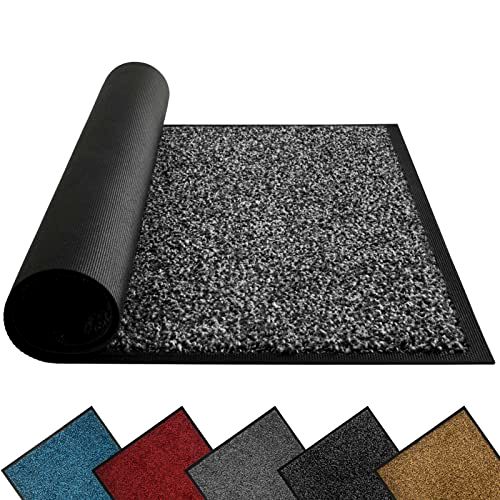
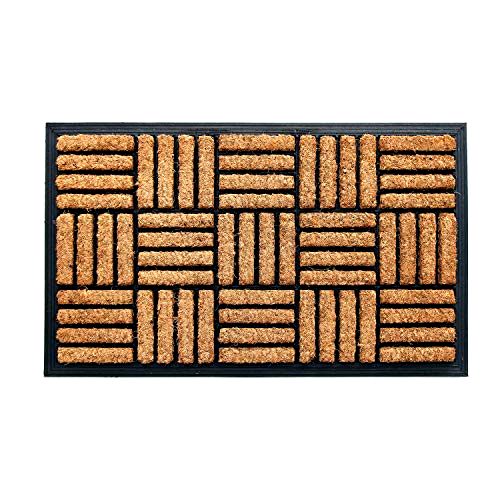
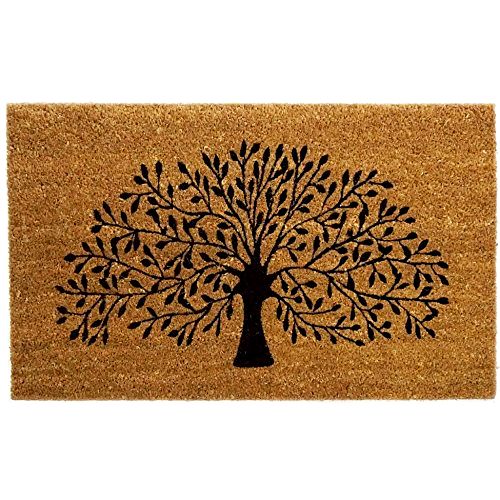
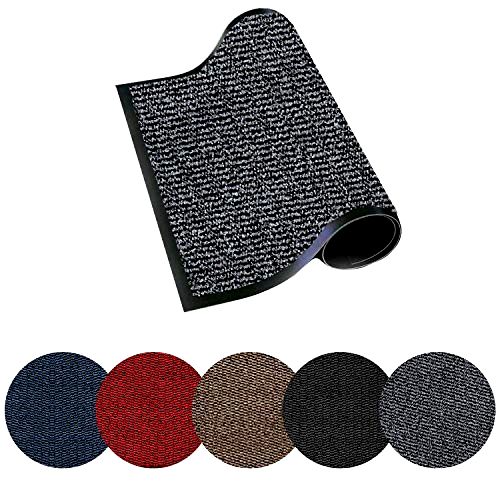
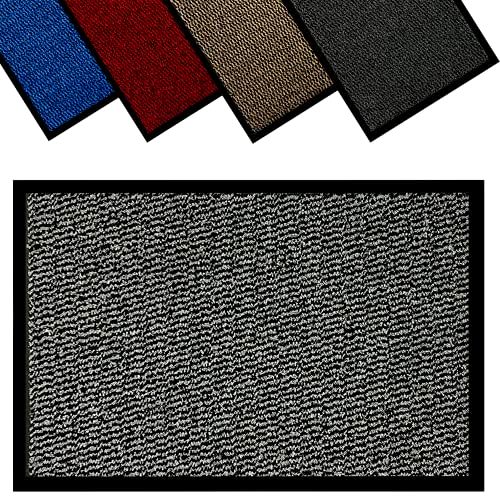
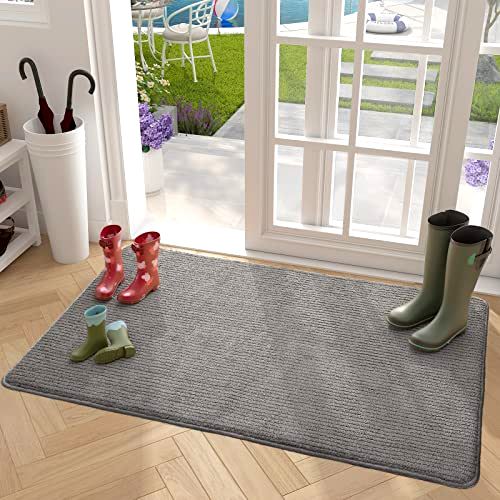
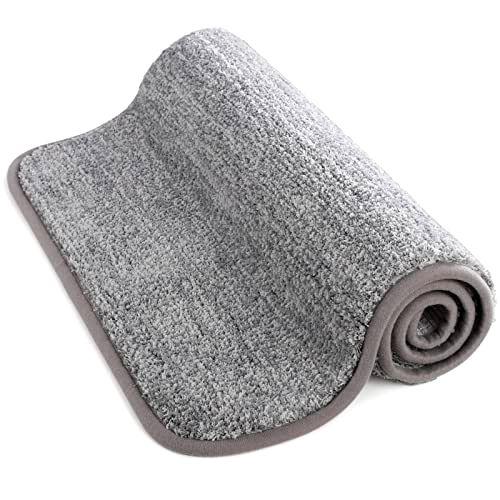
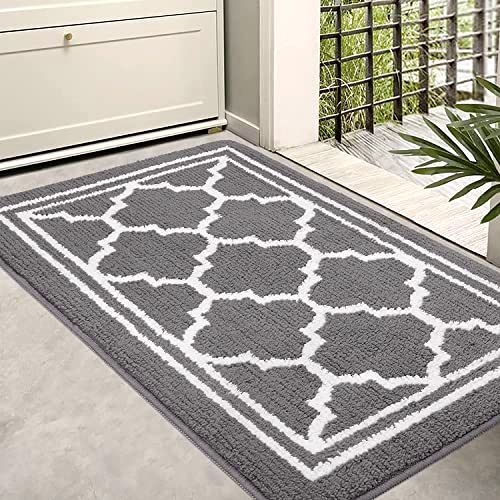
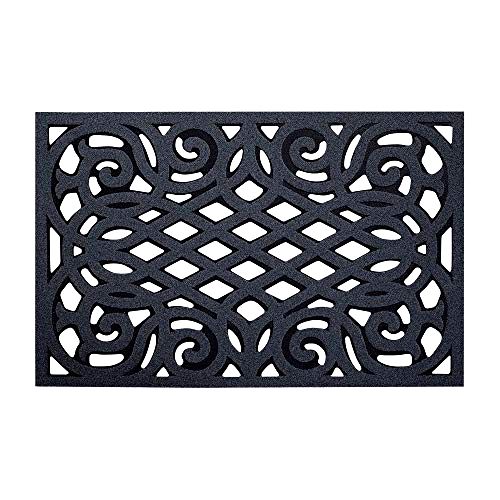
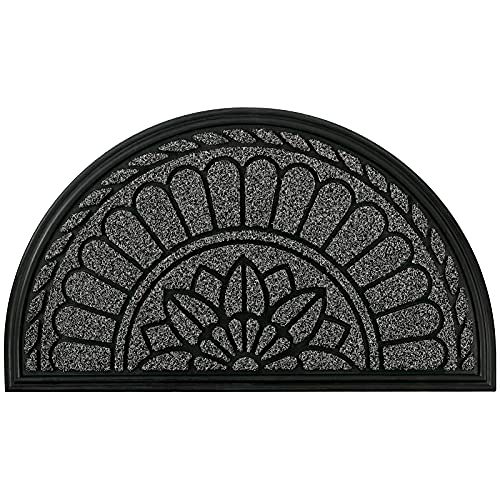

Share